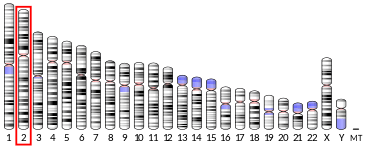ALPPL2
Alkaline phosphatase, placental-like 2 is a protein that in humans is encoded by the ALPPL2 gene.[5]
| ALPG | |||||||||||||||||||||||||
|---|---|---|---|---|---|---|---|---|---|---|---|---|---|---|---|---|---|---|---|---|---|---|---|---|---|
| Identifiers | |||||||||||||||||||||||||
| Aliases | ALPG, ALPPL, GCAP, alkaline phosphatase, placental like 2, ALPPL2, alkaline phosphatase, germ cell | ||||||||||||||||||||||||
| External IDs | OMIM: 171810 MGI: 108009 HomoloGene: 129600 GeneCards: ALPG | ||||||||||||||||||||||||
| |||||||||||||||||||||||||
| |||||||||||||||||||||||||
| |||||||||||||||||||||||||
| Orthologs | |||||||||||||||||||||||||
| Species | Human | Mouse | |||||||||||||||||||||||
| Entrez | |||||||||||||||||||||||||
| Ensembl | |||||||||||||||||||||||||
| UniProt | |||||||||||||||||||||||||
| RefSeq (mRNA) | |||||||||||||||||||||||||
| RefSeq (protein) | |||||||||||||||||||||||||
| Location (UCSC) | Chr 2: 232.41 – 232.41 Mb | Chr 1: 87.09 – 87.09 Mb | |||||||||||||||||||||||
| PubMed search | [3] | [4] | |||||||||||||||||||||||
| Wikidata | |||||||||||||||||||||||||
| |||||||||||||||||||||||||
Function
There are at least four distinct but related alkaline phosphatases: intestinal, placental, placental-like, and liver/bone/kidney (tissue non-specific). The product of this gene is a membrane bound glycosylated enzyme, localized to testis, thymus and certain germ cell tumors, that is closely related to both the placental and intestinal forms of alkaline phosphatase.[5]
gollark: Which is a blob running with literally every permission and I believe self update capabilities.
gollark: But apps frequently demand Google Play Services.
gollark: Ah yes. Oops.
gollark: Wait, no, that's -1/12 so it's fine.
gollark: As all engineers know, sin x = x. So the problem simplifies to the sum of nx/n = x with n from 1 to infinity, which doesn't converge, so you're wrong.
References
- GRCh38: Ensembl release 89: ENSG00000163286 - Ensembl, May 2017
- GRCm38: Ensembl release 89: ENSMUSG00000026246 - Ensembl, May 2017
- "Human PubMed Reference:". National Center for Biotechnology Information, U.S. National Library of Medicine.
- "Mouse PubMed Reference:". National Center for Biotechnology Information, U.S. National Library of Medicine.
- "Entrez Gene: Alkaline phosphatase, placental-like 2".
External links
- Human ALPPL2 genome location and ALPPL2 gene details page in the UCSC Genome Browser.
Further reading
- Shigenari A, Ando A, Baba T, Yamamoto T, Katsuoka Y, Inoko H (November 1998). "Characterization of alkaline phosphatase genes expressed in seminoma by cDNA cloning". Cancer Research. 58 (22): 5079–82. PMID 9823315.
- Henthorn PS, Knoll BJ, Raducha M, Rothblum KN, Slaughter C, Weiss M, Lafferty MA, Fischer T, Harris H (August 1986). "Products of two common alleles at the locus for human placental alkaline phosphatase differ by seven amino acids". Proceedings of the National Academy of Sciences of the United States of America. 83 (15): 5597–601. doi:10.1073/pnas.83.15.5597. PMC 386335. PMID 3461452.
- Jemmerson R, Shah N, Takeya M, Fishman WH (January 1985). "Characterization of the placental alkaline phosphatase-like (Nagao) isozyme on the surface of A431 human epidermoid carcinoma cells". Cancer Research. 45 (1): 282–7. PMID 2578098.
- Shen LP, Liu H, Kan YW, Kam W (June 1988). "5' nucleotide sequence of a putative human placental alkaline phosphatase-like gene". Nucleic Acids Research. 16 (12): 5694. doi:10.1093/nar/16.12.5694. PMC 336801. PMID 3387245.
- Lowe ME (February 1992). "Site-specific mutations in the COOH-terminus of placental alkaline phosphatase: a single amino acid change converts a phosphatidylinositol-glycan-anchored protein to a secreted protein". The Journal of Cell Biology. 116 (3): 799–807. doi:10.1083/jcb.116.3.799. PMC 2289307. PMID 1730777.
- Le Du MH, Stigbrand T, Taussig MJ, Menez A, Stura EA (March 2001). "Crystal structure of alkaline phosphatase from human placenta at 1.8 A resolution. Implication for a substrate specificity". The Journal of Biological Chemistry. 276 (12): 9158–65. doi:10.1074/jbc.M009250200. PMID 11124260.
- Fisken J, Leonard RC, Shaw G, Bowman A, Roulston JE (January 1989). "Serum placental-like alkaline phosphatase (PLAP): a novel combined enzyme linked immunoassay for monitoring ovarian cancer". Journal of Clinical Pathology. 42 (1): 40–5. doi:10.1136/jcp.42.1.40. PMC 1141788. PMID 2921344.
- Ben-Arie A, Hagay Z, Ben-Hur H, Open M, Dgani R (September 1999). "Elevated serum alkaline phosphatase may enable early diagnosis of ovarian cancer". European Journal of Obstetrics, Gynecology, and Reproductive Biology. 86 (1): 69–71. doi:10.1016/S0301-2115(99)00054-8. PMID 10471145.
- Goldstein DJ, Rogers C, Harris H (October 1982). "A search for trace expression of placental-like alkaline phosphatase in non-malignant human tissues: demonstration of its occurrence in lung, cervix, testis and thymus". Clinica Chimica Acta; International Journal of Clinical Chemistry. 125 (1): 63–75. doi:10.1016/0009-8981(82)90046-8. PMID 6814793.
This article incorporates text from the United States National Library of Medicine, which is in the public domain.
This article is issued from Wikipedia. The text is licensed under Creative Commons - Attribution - Sharealike. Additional terms may apply for the media files.



